Generating a 3D visualization quickly for marketing purposes instead of production ones, it is an interactive process between the designer and the 3D artist
For a few years ago, virtual prototyping has been accessible to many organizations. The real problem is the massive use of 3D products collections in the cloud. In this sense, 3DaaS platforms (3D as a service) are a solution that brings together the work of designers and other members of the development team in a single environment. Given its advantages in the professional field, leading companies already think about the possibilities of this technology within the scope of 3D visualization for marketing.
The current 3Daas application, which is led by the fashion and furniture marketing sectors, allows you to have an environment where creativity has no limits. In addition, it gives a desirable quality from a professional point of view. And it’s only necessary some information, such as sketches and images, to create it. As well as a friendly workflow based on an online collaborative platform.
Let’s go step by step
The use of 3Daas involves the application of specific skills that differ from those required in 3D systems based in CAD. Currently, 3D visualization software platforms answer some demands similar to the cinema ones or video game industry. But they have different features, so it is necessary to combine different computer solutions to manage this type of projects.
For its part, the generation of 3D visualizations for advertising and marketing is carried out through a process that includes different factors. All those factors are related to the creation of the product: the designer, the 3D artist and the client himself. In this way, the most strong 3DaaS platforms give the possibility that these three entities interact to achieve high quality results.
Once the desired solutions have been obtained, sometimes there is a need to share them and cooperate in spaces for virtual exhibition. As well as incorporating new functionalities to 3DaaS applications to extend their performance. And at this point, experts expect a paradigm change from B2B to B2C
The challenges to climb this technology for B2C
Theoretically, almost any operator of 3D visual art software can create, for example, fashion models or furniture. But the reality is much more complex. The task of “sculpting” 3D smooth surface textures like upholstery or hard surface elements, it requires a different approach. If you want your product look photorealistic, there are some considerations that must be taken into account. So it is necessary to create it by using a wide range of software solutions.
The current work experience shows that generating a 3D visualization quickly for marketing purposes instead of production is an interactive process between the designer and the 3D artist. In this way, the strongest 3DaaS platforms offer the option of supporting interactions between the client and 3D artists. Therefore, the intention is to achieve a result based entirely on the designers idea, with all properties of the fabric and its adjustment.
After creating the 3D representation, the client would like to share and collaborate in a virtual showroom. So any platform should provide its users the option to share and collaborate. This is an area in full development.
Entrance way
Fashion and furniture companies have noticed that their customers already have a tool that can support this technology. On the other hand, consumers are increasing the use of video and photographic functions. And they expect that their reference brands will provide them a commercial experience that takes full advantage of their phones’ potential.
Regarding retailers, if they want to reach the heart of their faithful, they should take advantage of the technological advances that are taking place in this direction to design interactive virtual showrooms and more attractive applications. The integration of online service platforms with camera and video accessories will be the key.
The growing integration between virtual adjustment, databases, e-commerce platforms, social networks and automated production is destined to support lot of orders in the near future.
3DaaS at the center of the process
Executing 3DaaS as a way of linking between designers and consumers will employ 3D artists in different time zones, collaborating through a dedicated platform that can manage the entire 3D production workflow, supporting the management of jobs almost 24 hours.
To reduce the impact of certain phases of mass production, it will be necessary to promote more changes in the workflow and enhance certain developments in the 3D visualization section with the aim of reducing the human factor related to the application of the visual effect.
Artificial Inteligente (AI) comes into play
The key to achieve faster and more accurate 3D simulations will be by integrating Artificial Intelligence with the current visualization software. In parallel, the AI will also improve some aspects like: predicting calculations of draping less solid elements, forecasting the behavior for different layers, appliying textures and the efficiency of these representations.
AI, in general, is already integrated into some 3D visualization software solutions and is being including into e-commerce platforms, as well as virtual applications.
Finally, another decisive factor to reduce time and accuracy of 3D visualization for marketing will be the ability to use less input materials. And this will undoubtedly contribute to increase the predisposition of consumers when working with these tools.
